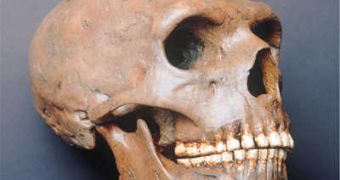350,000 to 45,000 years ago, Europe's only humans were the Neanderthals. These people were adapted to a cold climate, having a large braincase, short but robust bodies and large noses, and the males were about 1.65 m tall (5' 5") and inhabited Europe and neighboring areas of western Asia. Even if their brains were larger than ours are, many regard this extinct human as having a less complex behavior than ours.
Still, the Neanderthals buried their dead. In some cases, their burials included grave goods, like bison and aurochs bones, tools and the pigment ochre. They built complex shelters, controlled fire and skinned animals and could have practiced cannibalism, as Spanish discoveries suggested. There is evidence that the Neanderthals used a lot of wood. They used spears as thrusting weapons.
Now, two molar teeth around 63,400 years old show that the Neanderthals could have practiced dental hygiene.
The teeth present "grooves formed by the passage of a pointed object, which confirms the use of a small stick for cleaning the mouth," said Paleontology Professor Juan Luis Asuarga, showing the discovery in Madrid. "The fossils, unearthed in Pinilla del Valle, are the first human examples found in the Madrid region in 25 years. There are two (teeth), perfectly preserved, in which the wear and tear of a human of about 30 years old is perceptible", was added in a government statement.
The site also contained various animal fossils, from hyenas and bears to deer and rhinoceroses.
Spain is also the place were the last Neanderthals lived. The Neanderthals started to be displaced around 45,000 years ago by modern humans (Homo sapiens), but some small populations held on for millennia in regional pockets, like in happened in Croatia, Spain and the Crimean peninsula. The last known population dwelled on a cave system of Gibraltar, 30,000 to 24,000 years ago.
Scientists have also observed a mouth care behavior in chimps, which - after eating meat - "clean" their teeth and mouth by ingesting various leaves.

 14 DAY TRIAL //
14 DAY TRIAL //